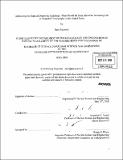Addressing the risks of diagnostic radiology : what should be done about the increasing use of computed tomography in the United States
Author(s)
Eastwick, Gary (Gary A.)
DownloadFull printable version (2.015Mb)
Alternative title
What should be done about the increasing use of computed tomography in the United States
Other Contributors
Massachusetts Institute of Technology. Dept. of Nuclear Science and Engineering.
Advisor
Jacquelyn C. Yanch.
Terms of use
Metadata
Show full item recordAbstract
Computed tomography (CT) is a prominent procedure in the US with larger radiation doses than traditional radiology. CT is a powerful tool in the diagnosis of a wide variety of conditions and its use has grown quickly because of its power. CT contributes a significant portion of annual per capita dose in the US. The risk of this additional dose is poorly understood. The risks of low doses of radiation are estimated through models, primarily the linear no-threshold (LNT) model. Epidemiological evidence from atomic bomb survivors provides some understanding of the risk of low doses of radiation, but not on the order of doses from typical CT procedures. This paper explores the evidence of the risk of low doses of radiation and discusses some of the models proposed. Recommendations for improving these models are made including experimental and epidemiological studies. Recommendations for reducing radiation exposure through the intelligent use of CT are also presented including: using CT only when it produces a clear clinical benefit, reducing dose per scan, and tracking total patient dose. Finally, a case is made that a thorough understanding of the risk versus dose relationship at doses relevant to CT is not necessary to use CT appropriately. The culture of evidence-based medicine will achieve this result without conscious efforts to reduce patient radiation exposure.
Description
Thesis (S.B.)--Massachusetts Institute of Technology, Dept. of Nuclear Science and Engineering, 2010. Cataloged from PDF version of thesis. Includes bibliographical references (p. 29-30).
Date issued
2010Department
Massachusetts Institute of Technology. Department of Nuclear Science and EngineeringPublisher
Massachusetts Institute of Technology
Keywords
Nuclear Science and Engineering.